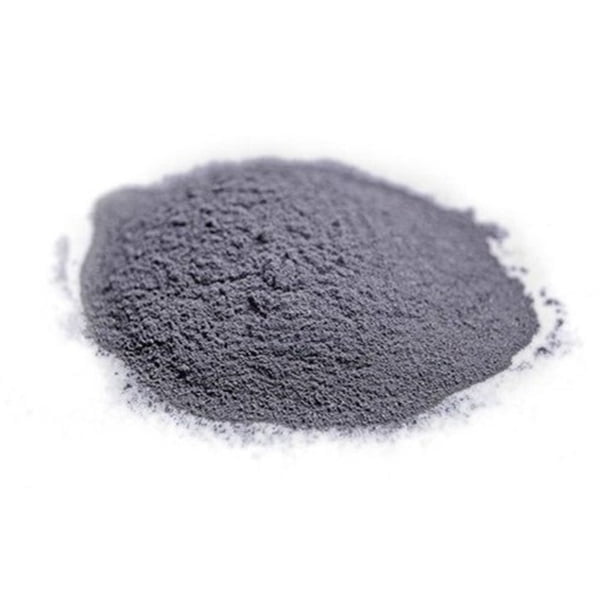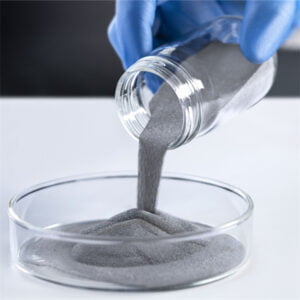použití DMLS v letectví a kosmonautice
Obsah
Představte si výrobu složitých leteckých dílů s bezkonkurenční konstrukční svobodou, snížení hmotnosti a zároveň zvýšení výkonu - to je kouzlo přímého laserového spékání kovů (Direct Metal Laser Sintering).DMLS) v leteckém průmyslu. Tato revoluční technologie 3D tisku rychle mění způsob navrhování, výroby a využití komponentů v letadlech, satelitech i jinde. Připoutejte se, protože se ponoříme do fascinujícího světa DMLS v letectví a kosmonautice, prozkoumáme její aplikace, specifické kovové prášky, které využívá, a vzrušující budoucnost, kterou slibuje.
DMLS: 3D tisk pro letectví a kosmonautiku
DMLS, známý také jako Direct Metal Laser Melting (DMLS®), je aditivní výrobní proces, který využívá vysoce výkonný laser k selektivnímu tavení částic kovového prášku vrstvu po vrstvě a vytváří 3D objekt z modelu CAD (Computer-Aided Design). Na rozdíl od tradičních subtraktivních výrobních technik, jako je obrábění, vytváří DMLS díly od základu, což nabízí celou řadu výhod pro letecké aplikace:
- Bezkonkurenční volnost designu: DMLS se vymaňuje z omezení konvenčních metod. Představte si vnitřní mřížkové struktury pro snížení hmotnosti, složité chladicí kanály pro zvýšení účinnosti motoru nebo díly s dříve nemožnou geometrií - to vše umožňuje DMLS.
- Odlehčovací schopnosti: V leteckém průmyslu se počítá každý gram. DMLS umožňuje konstruktérům navrhovat složité, lehké součásti, které výrazně snižují celkovou hmotnost letadel, což se projevuje ve vyšší palivové účinnosti a delším doletu.
- Rychlé prototypování a iterace: Možnost rychlé výroby složitých dílů přímo z modelů CAD umožňuje rychlou tvorbu prototypů a iteraci designu. To urychluje proces vývoje a zkracuje dobu uvedení nových leteckých technologií na trh.
- Snížení množství odpadu a úspora materiálu: Při DMLS se používá pouze nezbytný kovový prášek, čímž se minimalizuje množství odpadu ve srovnání s tradičními metodami, při nichž vzniká velké množství odpadního materiálu. To znamená úsporu nákladů a ekologičtější výrobní proces.

DMLS v akci: Přehlídka aplikací
Technologie DMLS není jen teoretická, ale přináší revoluci do leteckého průmyslu v reálných aplikacích:
- Letecké motory: Složité součásti motorů, jako jsou spalovače, vstřikovače paliva a lehké lopatky turbín se složitými vnitřními chladicími kanály, se stále častěji vyrábějí pomocí DMLS, což vede ke zvýšení účinnosti paliva a výkonu motoru.
- Konstrukce draku letadla: Technologie DMLS umožňuje vytvářet lehké a vysoce pevné součásti draku letadla, jako jsou konzoly, žebra a kování, což přispívá k celkovému snížení hmotnosti a zvýšení výkonu letadla.
- Satelity a kosmické lodě: Díky schopnosti vytvářet složité díly s vysokým poměrem pevnosti a hmotnosti je technologie DMLS ideální pro konstrukce družic, rozmístitelné mechanismy a dokonce i součásti pohonu, což otevírá cestu k lehčím a účinnějším kosmickým lodím.
- Bezpilotní letadla (UAV): Technologie DMLS se dokonale hodí pro rychlou výrobu prototypů a lehkých, na míru šitých součástí pro bezpilotní letadla, čímž podporuje inovace v rychle se rozvíjejícím odvětví dronů.
Arzenál kovových prášků
Úspěch DMLS závisí na konkrétních použitých kovových prášcích. Zde je pohled na některé z nejvýznamnějších konkurentů, z nichž každý má své jedinečné vlastnosti:
| Kovový prášek | Popis | Vlastnosti | Aplikace v letectví a kosmonautice |
|---|---|---|---|
| Slitiny titanu (Ti-6Al-4V, Ti-6Al-4V ELI): | Pracovní kůň leteckého DMLS, který nabízí vynikající poměr pevnosti a hmotnosti, vysokou odolnost proti korozi a biokompatibilitu (užitečné pro systémy podpory života kosmických lodí). | Vynikající mechanické vlastnosti, dobrá svařitelnost, biokompatibilní. | Lopatky turbín, součásti draků letadel, konstrukce kosmických lodí. |
| Inconel 625: | Vysoce výkonná nikl-chromová superslitina známá svou výjimečnou pevností při vysokých teplotách a odolností proti oxidaci. | Výjimečné vlastnosti při vysokých teplotách, dobrá odolnost proti korozi. | Spalovací motory, součásti horké části, vysokoteplotní aplikace v letectví a kosmonautice. |
| Slitiny hliníku (AlSi10Mg, Scalmalloy): | Hliníkové slitiny, které nabízejí dobrou rovnováhu mezi pevností, hmotností a tisknutelností, nacházejí stále větší uplatnění v leteckém DMLS, zejména pro nekritické součásti. | Lehký, dobrá potisknutelnost, určitá pevnostní omezení. | Lehké součásti draku, skříně, nekritické díly. |
| Nerezová ocel (316L): | Všestranná a cenově výhodná varianta, která nabízí dobrou odolnost proti korozi a obrobitelnost. | Dobrá odolnost proti korozi, obrobitelnost, střední pevnost. | Pouzdra, potrubí, nekritické součásti vyžadující odolnost proti korozi. |
| Kobalt-chrom (CoCr): | Biokompatibilní slitina s vynikající odolností proti opotřebení, což z ní činí cennou volbu pro některé aplikace v letectví a kosmonautice. | Vysoká odolnost proti opotřebení, biokompatibilní, dobrá pevnost. | Součásti podvozku, specifické aplikace opotřebení. |
| Slitiny mědi (CuNi) (pokračování): | Slitiny mědi, které mají vysokou tepelnou a elektrickou vodivost, nacházejí uplatnění v leteckém průmyslu pro výměníky tepla a elektrické součástky. | vodivost, dobrá elektrická vodivost. | Výměníky tepla, elektrické komponenty v kosmických lodích. |
| Molybden (Mo): | Žáruvzdorný kov známý svou výjimečnou pevností při vysokých teplotách a dobrou tepelnou vodivostí. | Vynikající výkon při vysokých teplotách, dobrá tepelná vodivost. | Žáruvzdorné komponenty pro raketové motory, tepelné štíty. |
| Tantal (Ta): | Další žáruvzdorný kov s velmi vysokým bodem tání a vynikající odolností proti korozi. | Velmi vysoký bod tání, dobrá odolnost proti korozi. | Kelímky pro manipulaci s roztaveným kovem, specifické vysokoteplotní aplikace. |
| Slitiny niklu (Rene 41, Inconel 718): | Skupina vysoce výkonných niklových slitin, které nabízejí kombinaci pevnosti, vysokoteplotního výkonu a dobré odolnosti proti oxidaci. | Vynikající mechanické vlastnosti, dobré vlastnosti při vysokých teplotách. | Turbínových lopatek, disků a dalších vysokoteplotních konstrukčních součástí proudových motorů. |
Výběr správného kovového prášku
Výběr optimálního kovového prášku pro DMLS je podobná práci dohazovače - vyžaduje pečlivé zvážení různých faktorů:
- Požadované vlastnosti: Výběr prášku se řídí specifickými potřebami dané součásti. Vysokoteplotní součásti motorů vyžadují prášky jako Inconel 625 nebo Rene 41, zatímco lehké součásti draku letadla mohou využívat hliníkové slitiny.
- Možnost tisku: Ne všechny kovové prášky jsou z hlediska tisknutelnosti stejné. Faktory jako velikost částic, tvar a tekutost významně ovlivňují úspěšnost procesu DMLS.
- Náklady: Cena kovových prášků se značně liší. Například slitiny titanu jsou obecně dražší než nerezová ocel. Je třeba najít rovnováhu mezi cenou a požadavky na výkon.
Výhody a omezení z DMLS
Přestože se DMLS může pochlubit celou řadou výhod, není bez omezení:
výhody:
- Bezkonkurenční volnost designu: DMLS otevírá dříve nepředstavitelné konstrukční možnosti a podporuje inovace a zvyšování výkonu.
- Odlehčení: Schopnost vytvářet složité a lehké konstrukce vede k výraznému snížení hmotnosti v leteckých aplikacích.
- Rychlé prototypování a iterace: DMLS urychluje vývojový proces tím, že umožňuje rychlou tvorbu prototypů a změny designu.
- Snížení množství odpadu: DMLS minimalizuje materiálový odpad ve srovnání s tradičními metodami, čímž podporuje udržitelnost.
Omezení:
- Dostupnost materiálu: Výběr snadno dostupných kovových prášků pro DMLS se ve srovnání s tradičními výrobními materiály stále vyvíjí.
- Povrchová úprava: Součásti vyrobené metodou DMLS mohou mít ve srovnání s obráběnými součástmi drsnější povrch, což může vyžadovat další kroky následného zpracování.
- Omezení velikosti dílů: Současné stroje DMLS mají omezené rozměry dílů, které mohou vyrábět.
- Náklady: Ačkoli DMLS nabízí dlouhodobé výhody, počáteční náklady na stroje DMLS a kovové prášky mohou být u některých aplikací vyšší než u tradičních metod.
Budoucnost DMLS v letectví a kosmonautice: Stoupá k novým výšinám
Budoucnost DMLS v letectví a kosmonautice není nic jiného než vzrušující. S rozvojem technologie můžeme očekávat:
- Vývoj nových kovových prášků: Nabídka snadno dostupných kovových prášků určených speciálně pro aplikace DMLS se bude nadále rozšiřovat a posouvat hranice možností.
- Větší objemy staveb: Stroje DMLS s většími konstrukčními obálkami se stanou běžnějšími, což umožní vytvářet ještě větší a složitější letecké komponenty.
- Vylepšená povrchová úprava: Pokrok v technologii DMLS povede k hladšímu povrchu, což může snížit potřebu rozsáhlého následného zpracování.
- Snížení nákladů: S tím, jak technologie DMLS dozrává a zvyšuje se její rozšíření, je pravděpodobné, že se celkové náklady na stroje a kovové prášky pro DMLS sníží, což ji učiní dostupnější pro širší škálu aplikací v letectví a kosmonautice.
DMLS není jen výrobní technologie, ale také katalyzátor inovací v letectví a kosmonautice. Díky uvolnění konstrukční svobody, snížení hmotnosti a zrychlení vývojových cyklů nás DMLS posouvá směrem k budoucnosti lehčích, efektivnějších a výkonnějších letadel, satelitů a kosmických lodí. Nebe je skutečně limitem pro DMLS v letectví a kosmonautice!

FAQ
Otázka: Jaké jsou výhody použití DMLS pro letecké aplikace?
Odpověď: DMLS nabízí řadu výhod, včetně bezkonkurenční volnosti designu, možnosti odlehčení, rychlé výroby prototypů a snížení množství odpadu ve srovnání s tradičními výrobními metodami.
Otázka: Jaká jsou některá omezení technologie DMLS?
O: Mezi omezení patří současný výběr snadno dostupných kovových prášků, potenciální problémy s povrchovou úpravou, omezení velikosti dílů a vyšší počáteční náklady ve srovnání s některými tradičními metodami.
Otázka: Jaké jsou budoucí trendy pro DMLS v leteckém průmyslu?
Odpověď: Budoucnost DMLS v leteckém průmyslu je neuvěřitelně slibná. Můžeme očekávat pokrok v několika klíčových oblastech:
Vývoj nových kovových prášků: Výrobci kovových prášků neustále inovují a vytvářejí nové prášky s vynikajícími vlastnostmi speciálně přizpůsobenými pro DMLS. Tím se ještě více rozšíří možnosti konstrukce, což umožní vytvářet součásti s ještě vyšším poměrem pevnosti a hmotnosti, lepším výkonem při vysokých teplotách a zvýšenou odolností proti korozi. Představte si, že exotické slitiny posunou hranice současných možností, způsobí revoluci ve výkonu motorů a povedou k vývoji nové generace leteckých vozidel.
Větší objemy staveb: Současné stroje DMLS mají omezenou velikost dílů, které mohou vyrábět. Budoucnost je však plná strojů s většími konstrukčními obálkami. To změní pravidla hry a umožní vytvářet celé části draku letadla, velké součásti raketových motorů, a dokonce i kompletní konstrukce satelitů přímo z 3D tiskárny. To otevírá dveře k výraznému snížení počtu dílů a složitosti montáže, což povede k lehčím a efektivnějším kosmickým lodím.
Vylepšená povrchová úprava: Zatímco díly z DMLS nabízejí výjimečnou funkčnost, jejich povrchová úprava může být ve srovnání s tradičně obráběnými součástmi drsnější. To může někdy vyžadovat další kroky následného zpracování, jako je leštění nebo obrábění. Pokroky v technologii DMLS však vedou k hladší povrchové úpravě přímo v procesu tisku. Tím se nejen sníží potřeba následného zpracování, ale také se potenciálně zlepší výkon některých součástí vytvořením hladších cest proudění vzduchu nebo snížením tření.
Snížení nákladů: Očekává se, že s tím, jak technologie DMLS dozrává a zvyšuje se její rozšíření, budou celkové náklady na stroje DMLS a kovové prášky klesat. Díky tomu se DMLS stane životaschopnější volbou pro širší škálu leteckých aplikací, nejen pro špičkové, výkonově kritické součásti. Tato demokratizace DMLS má potenciál urychlit inovace v celém leteckém průmyslu.
Závěrem
DMLS není jen výrobní technologie, ale také revoluce v leteckém průmyslu. Díky uvolnění konstrukční svobody, snížení hmotnosti, zrychlení vývojových cyklů a podpoře udržitelnosti nás DMLS žene vstříc budoucnosti lehčích, efektivnějších a vysoce výkonných létajících strojů. S dalším vývojem technologie DMLS jsou možnosti skutečně neomezené. Budoucnost letectví a kosmonautiky nepochybně utváří technologie DMLS a nebe skutečně není limitem - je teprve na začátku!
Sdílet na
MET3DP Technology Co., LTD je předním poskytovatelem řešení aditivní výroby se sídlem v Qingdao v Číně. Naše společnost se specializuje na zařízení pro 3D tisk a vysoce výkonné kovové prášky pro průmyslové aplikace.
Dotaz k získání nejlepší ceny a přizpůsobeného řešení pro vaše podnikání!
Související články

Vysoce výkonné segmenty lopatek trysek: Revoluce v účinnosti turbín díky 3D tisku z kovu
Přečtěte si více "O Met3DP
Nedávná aktualizace
Náš produkt
KONTAKTUJTE NÁS
Nějaké otázky? Pošlete nám zprávu hned teď! Po obdržení vaší zprávy obsloužíme vaši žádost s celým týmem.

Kovové prášky pro 3D tisk a aditivní výrobu
SPOLEČNOST
PRODUKT
kontaktní informace
- Město Qingdao, Shandong, Čína
- [email protected]
- [email protected]
- +86 19116340731
















